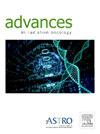全身放射与化疗为基础的清髓异基因造血细胞移植术后口腔黏膜炎和微生物群损伤的不同模式
IF 2.7
Q3 ONCOLOGY
引用次数: 0
摘要
目的口腔黏膜炎(OM)是同种异体造血细胞移植的常见并发症,可引起疼痛、感染、吞咽/语言障碍和生活质量下降。我们假设,在高剂量全身照射(TBI)和基于化疗的清髓调节后,OM和口腔微生物群破坏的模式(严重程度和动态)可能不同。方法和材料我们进行了一项探索性研究,包括全面的、纵向的粘膜炎评估,结合龈上斑块和唾液收集。在基线和+7、+14、+21、+28和+84天评估OM。使用有效的评分系统,根据2个领域和9个口腔部位的客观结果计算每个时间点的总粘膜炎评分。使用散弹枪宏基因组测序分析斑块和唾液样本(基线和+14、+28和+84天)。结果共进行249次OM评估,收集47例患者的342份样本(27例基于化疗,20例基于tbi)。在以化疗为基础的队列中,唾液流率保持稳定,但在以tbi为基础的队列中稳步下降,在第84天,与基线和以化疗为基础的队列相比,以tbi为基础的队列的唾液流率显著降低。在以tbi为基础的队列中,OM严重程度在第7天达到峰值,而在以化疗为基础的队列中,OM严重程度在第14天达到峰值。在基于化疗的队列中,第+14天OM明显更严重;其他时间点也没有什么不同。尽管各组在基线时斑块微生物群组成相似,但在造血细胞移植后的所有时间点上,它们变得显著不同。两组患者的唾液菌群组成无显著差异。在tbi队列中,第84天斑块微生物群多样性明显更高。结论:我们证明了创伤性脑损伤后与化疗后不同的OM、微生物群损伤和唾液流速模式。如果在未来的研究中得到验证,我们的研究结果可以加强以证据为基础的移植前口腔毒性咨询,并对移植幸存者的短期和长期口腔健康产生影响。本文章由计算机程序翻译,如有差异,请以英文原文为准。
Different Patterns of Oral Mucositis and Microbiota Injury After Total Body Irradiation- Versus Chemotherapy-Based Myeloablative Allogeneic Hematopoietic Cell Transplantation
Purpose
Oral mucositis (OM) is a common complication of allogeneic hematopoietic cell transplantation, causing pain, infections, swallowing/speech impairment, and poor quality of life. We hypothesized that patterns (severity and dynamics) of OM and oral microbiota disruptions may be different after high-dose total body irradiation (TBI)- versus chemotherapy-based myeloablative conditioning.
Methods and Materials
We conducted an exploratory study including comprehensive, longitudinal mucositis assessment, paired with supragingival plaque and saliva collection. OM was assessed at baseline and days +7, +14, +21, +28, and +84. Total mucositis score at each timepoint was calculated from objective findings in 2 domains and 9 oral sites using a validated scoring system. Plaque and saliva samples (baseline and days +14, +28, and +84) were profiled using shotgun metagenomic sequencing.
Results
A total of 249 OM assessments were performed and 342 samples were collected from 47 patients (27 chemotherapy-based, 20 TBI-based). Salivary flow rate remained stable in the chemotherapy-based cohort, but steadily declined in the TBI-based cohort, reaching a significantly lower level in the TBI-based cohort at day +84 both compared to baseline and the chemotherapy-based cohort. OM severity peaked at day +7 in the TBI-based cohort versus day +14 in the chemotherapy-based cohort. Day +14 OM was significantly more severe in the chemotherapy-based cohort; other timepoints were not different. Although the cohorts were similar in plaque microbiota composition at baseline, they became significantly different at all post- hematopoietic cell transplantation timepoints. Salivary microbiota composition was not significantly different between the 2 cohorts. Day +84 plaque microbiota diversity was significantly higher in the TBI-based cohort.
Conclusions
We demonstrated different patterns of OM, microbiota injury, and salivary flow rate after TBI- versus chemotherapy-based conditioning. If validated in future studies, our findings could enhance evidence-based pretransplant counseling on oral toxicity and have implications for short- and long-term oral health in transplant survivors.
求助全文
通过发布文献求助,成功后即可免费获取论文全文。
去求助
来源期刊

Advances in Radiation Oncology
Medicine-Radiology, Nuclear Medicine and Imaging
CiteScore
4.60
自引率
4.30%
发文量
208
审稿时长
98 days
期刊介绍:
The purpose of Advances is to provide information for clinicians who use radiation therapy by publishing: Clinical trial reports and reanalyses. Basic science original reports. Manuscripts examining health services research, comparative and cost effectiveness research, and systematic reviews. Case reports documenting unusual problems and solutions. High quality multi and single institutional series, as well as other novel retrospective hypothesis generating series. Timely critical reviews on important topics in radiation oncology, such as side effects. Articles reporting the natural history of disease and patterns of failure, particularly as they relate to treatment volume delineation. Articles on safety and quality in radiation therapy. Essays on clinical experience. Articles on practice transformation in radiation oncology, in particular: Aspects of health policy that may impact the future practice of radiation oncology. How information technology, such as data analytics and systems innovations, will change radiation oncology practice. Articles on imaging as they relate to radiation therapy treatment.
 求助内容:
求助内容: 应助结果提醒方式:
应助结果提醒方式:


